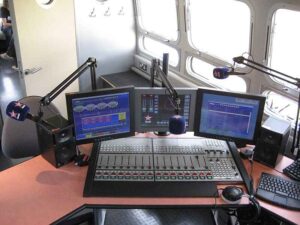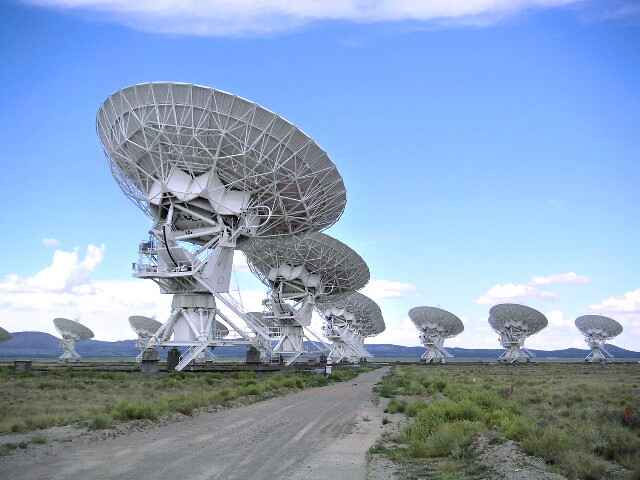3 Types of Radio Waves and their Characteristics Explained
Types of radio waves are; analog, digital and hybrid radio waves, based on mode of signal-transmission.
This article discusses the types of radio waves and their characteristics, as follows;
1). Analog Radio Waves (as one of the Types of Radio Waves)
Generally, an analog signal is a signal that varies continuously according to a temporal (time-based) parameter. Examples of analog signals include television and radio signals.
An analog radio wave (or radio signal) is a type of radio wave that is propagated as a continuous, sinusoidal stream of electromagnetic charges [6].
In most cases, the analog radio wave is used to communicate only audio/voice information.
The sinusoidal waveform of analog radio signals, allow them to maintain a stable range of temporal variation.
Analog radio waves are usually frequency-modulated, so that they may be described as FM waves. Based on frequency, the types of analog radio waves can be distinguished as; high-frequency (HF), very-high frequency (VHF) and ultra-high frequency (UHF) [4].
Modulation helps to encode voice information into the radio waves before they are transmitted, in order to enable a receiver (that is tuned to the same frequency range) to easily detect and clearly decode the information.
It must be noted that analog transmission is not always confined to frequency modulation, as most analog radio waves are also amplitude-modulated (AM). The uniqueness of these waves only lies in the fact that frequency modulation is given priority as a means of encoding information into the waves.
Because they are frequency-modulated, the detection of these waves is only possible within the boundaries their modulated frequency, so that any signals picked up at the upper or lower extremes of this range may be decoded as white noise.
Analog radio waves differ from digital radio waves in terms of performance, by having lower signal-clarity, due to their lack of a definitive amplitude range.
Radios that are designed to work only with analog waves are referred to as analog radios.

2). Digital Radio Waves
Digital radio waves are waves whose signals are encoded as digits before being transmitted, so that they can only be decoded by a digital receiver which extracts the information contained in these transmitted, digitalized waves [5].
The operational difference between analog and digital radio waves is that digital waves do not depend heavily on frequency and amplitude range-modulation, to be encoded and decoded effectively.
Utilization of digital radio waves is a more recent development, whose introduction can be attributed to advances in analytic, radiological, and data management technologies.
The frequencies of digital radio waves range from tens of megahertz to few gigahertz, in general. Unlike analog, digital radio signals do not necessarily operate within a given range of frequency, but may rather be specified to a single, decimal digit; so that a receiver that is tuned to this specific digit can decode high-quality audio and visual information.
In addition to providing higher-quality signals, digital radio waves are better than analog waves in terms of energy intensiveness, efficiency of transmission, and geographical reach.
By transmitting information as digits, digital radio wave technologies conserve energy that would otherwise be used for continuous bandwidth control and wave modulation, while increasing the ease of signal detection.
When it is used solely for voice signals, digital radio wave transmission is also called Digital Audio Broadcasting (DAB, or DAB+) [1], which is a universally accepted mode of radio transmission.

3). Hybrid Radio Waves (as one of the Types of Radio Waves)
Hybrid radio waves are a type of radio waves which have some characteristics of both analog and digital waves. They are also called analog-digital radio waves.
The production of hybrid radio waves usually occurs in two main steps, which are; analog radio wave production by frequency/amplitude modulation, and analog wave conversion to digital waves (also called analog-to-digital conversion, or analog wave digitalization).
The most common hybrid radio wave system is the analog-to-digital converter (ADC), which converts modulated analog waves to digital signals that can be easily transmitted and decoded [2].
Hybrid radio waves are needed where the data to be transmitted is large and complex, as it serves as a medium for delivering high-quality signals of such information.
Some hybrid radio wave systems are not contactless in their mode of transmission, and require a medium like optical fibers, to transmit wave signals [3]. This is usually the case for continuous hybrid waves with significant frequency modulation.
The concept of hybrid transmission can be used with other electromagnetic waves like microwaves and light waves.
Conclusion
Types of radio waves are;
1. Analogue Radio Waves
2. Digital Radio Waves
3. Hybrid Radio Waves
References
1). Falkowski-Gilski, P. (2021). "Digital Transformation of Terrestrial Radio: An Analysis of Simulcasted Broadcasts in FM and DAB+ for a Smart and Successful Switchover." Applied Sciences, 2021; 11(23):11114. Available at: https://doi.org/10.3390/app112311114. (Accessed 29 March 2023).
2). Li, D.; Zhao, X.; Liu, S.; Liu, M.; Ding, R.; Liang, Y.; Zhu, Z. (2022). "Radio frequency analog-to-digital converters: Systems and circuits review." Microelectronics Journal, Volume 119, January 2022, 105331. Available at: https://www.sciencedirect.com/science/article/abs/pii/S0026269221003128. (Accessed 29 March 2023).
3). Ning, B.; Hou, D.; Zheng, T.; Zhao, J. (2013). "Hybrid Analog-Digital Fiber-Based Radio-Frequency Signal Distribution." in IEEE Photonics Technology Letters, vol. 25, no. 16, pp. 1551-1554, Aug.15, 2013. Available at: https://doi.org/10.1109/LPT.2013.2270298. (Accessed 29 March 2023).
4). Raab, F. H.; Caverly, R.; Campbell, R.; Eron, M.; Hecht, J. B.; Mediano, A.; Myer, D. P.; Walker, J. L. B. (2002). "HF, VHF, and UHF systems and technology." IEEE Transactions on Microwave Theory and Techniques 50(3):888 - 899. Available at: https://doi.org/10.1109/22.989972. (Accessed 29 March 2023).
5). Ramsay, R. (2011). "Digital radio: all you need to know." Available at: https://www.cnet.com/tech/tech-industry/digital-radio-all-you-need-to-know/. (Accessed 29 March 2023).
6). ZhongKai, Z., Xuecheng, J.; Ping, C. (2018). "Program and circuit design of simple software radio FSK based on MCU." Procedia Computer Science 131:440-445. Available at: https://doi.org/10.1016/j.procs.2018.04.250. (Accessed 29 March 2023).





